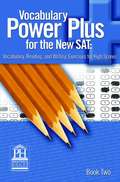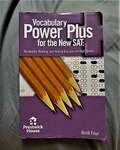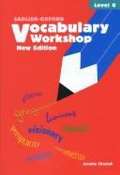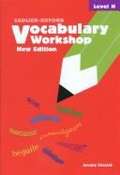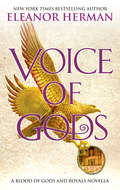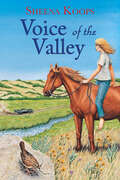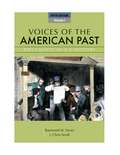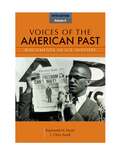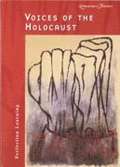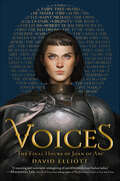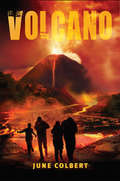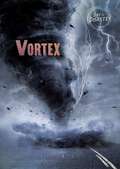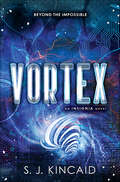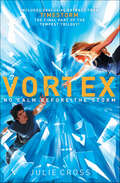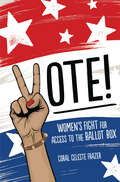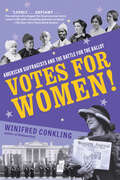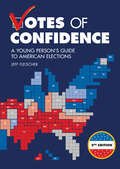- Table View
- List View
Vocabulary Power Plus for the ACT (Book One)
by Daniel A. ReedVocabulary Power Plus for the ACT will help you: * Introduce students to the ACT test format with ACT-style multiple choice questions * Build student writing skills with practical, ACT-style writing prompts * Reinforce correct grammar usage with ACT-style exercises * Use proven techniques to help students gain skills using word-in-context questions; prefix, suffix, and root practice; inference questions; and critical reading exercises
Vocabulary Power Plus for the New SAT
by Daniel A. ReedYour students will score higher on the SAT once they've used Prestwick House's Vocabulary Power Plus for the New SAT, the only program that addresses all of the revisions in the test without compromising the vocabulary studies students need. Each unit alternates focusing on the critical reading and essay portions of the test with questions focusing on sentence completion, reading comprehension, inference, essay, root practice, and more. Review units ensure your students will remember what they've learned.
Vocabulary Power Plus for the new SAT
by Daniel A. ReedIntended for 12th grade. <P><P>Your students will score higher on the SAT once they've used Prestwick House's Vocabulary Power Plus for the New SAT, the only program that addresses all of the revisions in the test without compromising the vocabulary studies students need. Each unit alternates focusing on the critical reading and essay portions of the test with questions focusing on sentence completion, reading comprehension, inference, essay, root practice, and more. Review units ensure your students will remember what they've learned. <P><P>Why should you use Vocabulary Power Plus? You'll save time because you won't have to write vocabulary lessons from scratch. Reading passages similar to those on the SAT* help students learn words by examining their contexts. Multiple exercises reinforce the meanings of words to students, fostering long-term knowledge. Your students will learn more than 200 new words in each book. You'll tackle vocabulary instruction and test prep with one resource.
Vocabulary Workshop, Common Core Enriched Edition, Level G
by Jerome Shostak Vicki A. Jacobs Louis P. De AngeloA publisher-supplied textbook
Vocabulary Workshop, Common Core Enriched Edition, Level H
by Jerome Shostak Vicki A. Jacobs Louis P. De AngeloA publisher-supplied textbook
Vocabulary Workshop: Level G (New Edition)
by Jerome ShostakThis text prepares students for the new standardized tests and teaches 300 essential vocabulary words per level.
Vocabulary Workshop: Level H
by Jerome ShostakPrepare students for the new standardized tests and teach 300 essential vocabulary words per level.
Vocabulary for the College-Bound Student
by Harold Levine Norman Levine Robert T. LevineTo provide meaningful, organized vocabulary improvement for the high school student whose goals may be college admission, a responsible position, or self-improvement.
Voice of Gods
by Eleanor HermanAt nineteen, Ada of Caria yearns to take the Snake Blood throne from her mad older siblings. She seeks the help of a young orphaned girl named Helen, the first True Oracle to have walked the earth in more than three hundred years.Helen may be able to channel the voice of the gods, but she hates her gift and will do anything to get rid of it--even lie to her best friend, Myrtale, the priestess-princess of Epirus who is destined to marry King Philip II of Macedon even though she loves another.And in the shadows lurks a handsome green-eyed stranger who has more at stake--and more to lose--than anyone could possibly imagine.Amid jealousy and heartbreak, torrid affairs and secret rendezvous, it is spoken by the gods that either Helen or Myrtale--newly named Olympias--will carry the destiny of the known world within her womb.The prequel to Legacy of Kings, Voice of Gods traces the intricate web of love and betrayal that led up to the birth of history's most powerful leader, Alexander the Great.
Voice of the Valley
by Sheena KoopsVoice of the Valley is a poetic, multi-layered, coming-of-age story inspired by the controversial flooding of Saskatchewan's Souris Valley. Onja Claibourn is almost fifteen. Her world is one of sage, buffalo bills, brown-eyed susans, cactus, flax, buckbrush, foxtail and orange moss—the world of the valley just beyond the family farm. Old roads twist like a game of snakes and ladders into the valley. Onja and her horse Ginger spend their summer days in exploration. But things begin to change when Onja discovers first an archeological dig and then the startling fact that there is a plan to dam and flood her valley. She cannot contemplate this change to the landscape she loves so much. And when she also discovers sixteen-year-old Etthen, working with the archaeologists, she begins those first faltering footsteps toward a totally unfamiliar landscape—romantic love. Onja Claibourn is a wonderfully complex and very real character—innocent, wise, shy, stubborn, playful, and caring. The other major character in the novel is the prairie landscape itself—huge sky, harsh sun, rolling hills, sweeping fields of grain.
Voices from the March on Washington
by George Ella Lyon J. Patrick LewisThe powerful poems in this poignant collection weave together multiple voices to tell the story of the March on Washington, DC, in 1963. From the woman singing through a terrifying bus ride to DC, to the teenager who came partly because his father told him, "Don't you dare go to that march," to the young child riding above the crowd on her father's shoulders, each voice brings a unique perspective to this tale. <P><P> As the characters tell their personal stories of this historic day, their chorus plunges readers into the experience of being at the march--walking shoulder-to-shoulder with strangers, hearing Martin Luther King Jr.'s famous speech, heading home inspired.
Voices of the American Past: Documents in U.S. History, Volume I
by Raymond M. Hyser J. Chris ArndtNIMAC-sourced textbook
Voices of the American Past: Documents in U.S. History, Volume II
by Raymond M. Hyser J. Chris ArndtNIMAC-sourced textbook
Voices of the Holocaust
by Perfection Learning CorporationContains short stories, poems, biographical accounts, and essays about the Holocaust intended to help readers answer the question: Could a holocaust happen here?
Voices: The Final Hours of Joan of Arc
by David Elliott"Stunning . . . elegant . . . arresting . . . supple and harrowing.” - The Wall Street Journal★“An innovative, entrancing account of a popular figure that will appeal to fans of verse, history, and biography.” - Kirkus, starred reviewIn poems that surprise and move readers, bestselling author David Elliott explores how Joan of Arc changed the course of history and remains a figure of fascination centuries after her extraordinary life and death.Told through medieval poetic forms and in the voices of the people and objects in Joan of Arc’s life, (including her family and even the trees, clothes, cows, and candles of her childhood), Voices offers an unforgettable perspective on an extraordinary young woman. Along the way it explores timely issues such as gender, misogyny, and the peril of speaking truth to power. Before Joan of Arc became a saint, she was a girl inspired. It is that girl we come to know in Voices.
Volcano
by June ColbertSara is fifteen and secretly in love with Kel Pearson. Her dad is a Meatball. Kel?s dad is a Meatball too. `Meatballs? like to jump into earthquakes and climb inside volcanoes to take their temperatures. When they clamber out, shoes burning and hair smoking, they pass their findings on to Coneheads. `Coneheads? analyse data and make recommendations to local governments. Together they make up an `AusDAR? team ? Disaster Assessment and Relief (Australian Division) ? experts in Disaster Casualty Minimisation. They?ve just been asked to go to the exotic Andes to gauge the safety of the new gas and oil pipeline being dug through the base of a sleepy little extinct volcano called Mt Cumbal. They are all set for the adventure of a lifetime ? after all, the volcano is in no danger of erupting. But what about that murky, brown water coming out of the tap in Sara?s caravan? It?s not supposed to smell like sulphur ? June Colbert, bestselling author of THE KING OF LARGE and THE LAST BOY, masterfully weaves together teenage themes of identity, pride, secret `crushes? and the sense of belonging in her well-researched, detailed and fast-paced novel VOLCANO.
Vortex (Day of Disaster)
by Vanessa ActonBlair and her brothers are driving home from a disastrous road trip when their day suddenly gets a whole lot worse. After facing down a tornado, their car is barely functioning, and the same can be said for Blair's older brother. Blair must take charge and get her family out of danger, but the storm isn't letting up. Will Blair be able to get her injured and scared brothers to safety . . . before the next twister hits?
Vortex (The Insignia Novels #2)
by S. J. KincaidS. J. Kincaid has created a fascinating dystopian world for Insignia, her futuristic science-fiction adventure series perfect for fans of Ender's Game. Earth is in the middle of WWIII, a war to determine which governments and corporations will control the resources of the solar system.Teen Tom Raines grew up with nothing—some days without even a roof over his head. Then his exceptional gaming skills earned him a spot in the Intrasolar Forces, the country's elite military training program, and his life completely changed.Now in Vortex, the second book in the series, Tom discovers that the Pentagonal Spire, where he and his friends are being trained as superhuman weapons, is filled with corruption. He is asked to betray his friends—the first real friends he's ever had—for the sake of his country.Will he sacrifice his new life to do what he believes is right?
Vortex (The Tempest Trilogy)
by Julie CrossJulie Cross's Vortex is the thrilling second installment of the Tempest series, in which the world hangs in the balance as a lovelorn Jackson must choose who to saveJackson Meyer has thrown himself into his role as an agent for Tempest, the shadowy division of the CIA that handles all time-travel-related threats. Despite his heartbreak at losing the love of his life, Jackson has proved himself to be an excellent agent. However, after an accidental run in with Holly—the girl he altered history to save—Jackson is once again reminded of what he's lost. And when Eyewall, an opposing division of the CIA, emerges, Jackson and his fellow agents not only find themselves under attack, but Jackson begins to discover that the world around him has changed and someone knows about his erased relationship with Holly, putting both their lives at risk all over again.
Vote!: Women's Fight for Access to the Ballot Box
by Coral Celeste FrazerAugust 18, 2020, marked the 100th anniversary of the 19th Amendment to the US Constitution, which prohibited states and the US government from denying citizens the right to vote on the basis of sex. See how the 70-year-long fight for women's suffrage was hard won by leaders such as Elizabeth Cady Stanton, Susan B. Anthony, Alice Paul, Carrie Chapman Catt and others. Learn how their success led into the civil rights and feminist movements of the mid- and late twentieth century, as well as today's #MeToo, #YesAllWomen, and Black Lives Matter movements. In the face of voter ID laws, voter purges, gerrymandering, and other restrictions, Americans continue to fight for equality in voting rights.
Votes for Women!: American Suffragists and the Battle for the Ballot
by Winifred ConklingFor nearly 150 years, American women did not have the right to vote. On August 18, 1920, they won that right, when the 19th Amendment to the Constitution was ratified at last. To achieve that victory, some of the fiercest, most passionate women in history marched, protested, and sometimes even broke the law—for more than eight decades. From Susan B. Anthony and Elizabeth Cady Stanton, who founded the suffrage movement at the 1848 Seneca Falls Convention, to Sojourner Truth and her famous “Ain’t I a Woman?” speech, to Alice Paul, arrested and force-fed in prison, this is the story of the American women’s suffrage movement and the private lives that fueled its leaders’ dedication. Votes for Women! explores suffragists’ often powerful, sometimes difficult relationship with the intersecting temperance and abolition campaigns, and includes an unflinching look at some of the uglier moments in women’s fight for the vote. By turns illuminating, harrowing, and empowering, Votes for Women! paints a vibrant picture of the women whose tireless battle still inspires political, human rights, and social justice activism.
Votes of Confidence, 2nd Edition: A Young Person's Guide to American Elections
by Jeff FleischerEvery two years, media coverage of American elections turns into a horse-race story about who's leading the polls and who said what when. Give young adult readers clear explanations about how our election process actually works, why it matters, and how they can become involved. Using real-world examples and anecdotes, this book provides readers with thorough, nonpartisan explanations about primaries, the electoral college, checks and balances, polls, fundraising, and more. Updated with facts, figures, and analysis, this edition provides the next generation of voters with essential guidance about the past, present, and future of American elections. "[A] very readable, engaging, and entertaining history of American elections and politics for young people. Highly recommended."—starred, Booklist "Fleischer presents a potentially didactic subject matter in a digestible and organized manner. Recommended for middle to high school students, educators, and others interested in becoming civically informed and engaged."—School Library Journal

